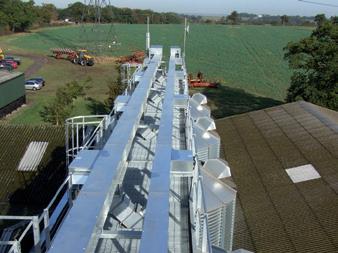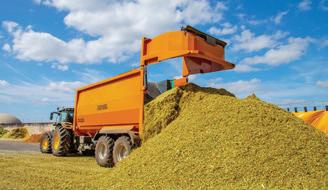Midland Farmer
News
Delay
Arable Thirsty
Technology
Livestock Net












Sugar
Clodhopper





News
Delay
Arable Thirsty
Technology
Livestock Net












Sugar
Clodhopper






ANTLER performed exceptionally in APHA variety list testing in the past 3 tough years. In 2024, extensive farm trials recorded consistent and exceptional yields leading it to be added to the very top of the BBRO Recommended List for 2026 sowing.
With lower bolting and higher sugar content than the market leader BTS1915, it offers better performance with lower risks.
Combine this with excellent seed quality, establishment, a good disease package and the opportunity to buy our proprietary priming and pellet plus a wider range of seed treatments, ANTLER really is the new Monarch of the Fen.
All seed is now sold directly from SESVANDERHAVE



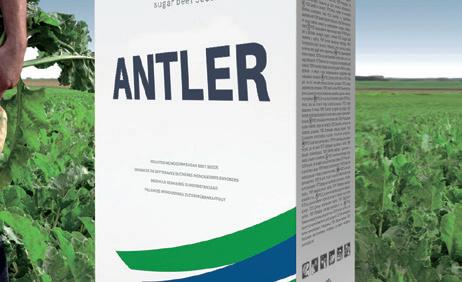


EDITORIAL
Editor:
Johann Tasker | T: 07967 634971
E: johann@ruralcity.co.uk
Design:
Mark Shreeve | T: 01502 725839
E: mark.shreeve@micropress.co.uk
Advertisement production:
Polly Coleman | T: 01502 725841
E: polly.coleman@micropress.co.uk
Gemma Mathers | T: 01502 725813
E: gemma.mathers@micropress.co.uk
Callum Hoffman | T: 01502 725840
E: callum.hoffman@micropress.co.uk
ADVERTISING SALES
Danny Lewis | T: 01502 725862
E: danny.lewis@micropress.co.uk
Harvey Taylor | T: 01502 725804
E: harvey.taylor@micropress.co.uk
Lawrence Kenny | T: 01502 725860
E: Lawrence.kenny@micropress.co.uk
Midland Farmer is a controlled circulation magazine published monthly for farmers and growers in the Midlands (Derbyshire, Herefordshire, Leicestershire, Lincolnshire, Northamptonshire, Nottinghamshire, Shropshire, Staffordshire, Warwickshire, West Midlands and Worcestershire) or companies supplying goods and services to the sector. To be included on the circulation list, a farmer must have a minimum of 70 acres of land, or 50 dairy/beef stock, or 50 breeding sows/250 growing stock, or 15,000 laying hens/broiler chickens. Intensive horticulture units are required to have a minimum of two hectares.
If you no longer wish to receive this magazine, please email your name, address and postcode as it appears on the wrapper to gemma.mathers@micropress.co.uk
© Countrywide Publications 2024
Published by Countrywide Publications, Fountain Way, Reydon Business Park, Reydon Suffolk IP18 6DH T: 01502 725800
Printed by Micropress Printers Ltd T: 01502 725800
ood politicians know when to change their minds – and aren’t afraid to do so when the time is right. Especially when mounting evidence suggests that doggedly pursuing a policy will harm the very people it was designed to protect.
This is the challenge facing the government after a cross-party group of MPs recommended that Chancellor Rachel Reeves delays plans to impose inheritance tax on farmers – and comes up with a more appropriate tax proposal instead.
The recommendation to delay is striking because the Environment, Food and Rural Affairs Committee includes seven Labour MPs. Without their support, the commitee’s call for a delay wouldn’t have seen the light of day.
It provides the Chancellor with an off-ramp –an opportunity for the government to back down with dignity on its controversial proposal to levy 20% inheritance tax on farming assets worth more than £1 million from April 2026.
Should she choose to do so, the Chancellor can cite the advice of her own backbenchers and show that she is prepared to listen and rethink one of

the most damaging policies of Labour’s short time in government.
It is unlikely that the inheritance tax proposal will be scrapped completely. But as the Tenant Farmers Association has pointed out, it is abundantly clear to anyone who has scrutinised the plan that it is not fit for purpose in its current form.
As TFA chief executive George Dunn has argued, the policy must be finessed before it is introduced so that it achieves the government’s stated aim of raising tax revenue and ensure that wealthy individuals cannot “hide” their wealth by buying farmland.
Farming organisations have proposed a number of ways that the government could tweak the policy to achieve its objectives while mitigating against the negative, unintended consequences of its current approach.
Time will tell whether the government will eventually listen. But huge damage will be caused to farming families should it fail to do so. It’s not only the right time for the Chancellor to back down –it’s long overdue.
Johann Tasker Editor









• Vulnerable farmers most at risk
• Tax impact disputed and unclear
• More time to seek proper advice
MPs have called for a year-long delay to government plans to impose inheritance tax on farm assets worth more than £1 million from 2026.
The cross-party Environment, Food and Rural Affairs (Efra) Committee said a 12-month pause “would allow for better formulation of tax policy” and give government ministers the chance to convey a positive longterm vision for farming.
Delaying the plan – due to come into effect from April 2026 – would also protect vulnerable farmers who would have “more time to seek appropriate professional advice,” said the Efra committee.
Rebuild trust
Changes announced in the autumn Budget 2024 were made without adequate consultation – or a proper impact and affordability assessment, said committee chairman Alistair Carmichael MP.
This meant the impact of the changes on family farms, land values, tenant farmers, food security and farmers across the UK was “disputed and
unclear” – with a risk of producing unintended consequences.
Mr Carmichael said: “There is an opportunity here to rebuild trust and confidence in the farming sector and I hope that the government will take our recommendations seriously.”
A raft of announcements – including the sudden closure of capital grants, the closure of Sustainable Farming Incentive scheme and the faster phase-out of direct payments –had left farmers feeling they could not rely on the government.

“The government, however, seems to be dismissing farmers’ concerns and ignoring the strength of feeling evidenced in the months of protests that saw tractors converge on Westminster and up and down the country.”
Poor and confusing
Defra’s communications with farmers have been poor, with confusing and sometimes contradictory messaging, said Mr Carmichael.
He added: “Policies affecting farmers have been announced without due consideration or explanation of their impact or rationale.”
“There has been a lack of adequate consultation
Some 70% of farmers felt optimistic about their rural businesses before the Budget, suggested a March 2025 survey. But that number fell to 12% afterwards, said Mr Carmichael.
“Farmers urgently need clarity, certainty and advance notice of changes – they cannot be expected to rethink their businesses on a whim. It is essential that Defra focuses on rebuilding trust through good-faith communications with the sector.”
A government spokesman said 75% of estates would continue to pay no inheritance tax at all under the plan – while the remaining quarter would “pay half the inheritance tax that most people pay”.
Defra is contacting thousands of farmers who were left in the lurch following the abrupt closure of the Sustainable Farming Scheme.
It follows a government decision to reopen the scheme to 3000 farmers who had started an application but not yet submitted it in the two months before the SFI was suddenly closed on 11 March. The farmers had threatened legal action over the closure.
The decision to reopen the scheme came after the group of farmers, supported by the NFU, wrote to Defra secretary Steve Reed to inform him of their intention to legally challenge his decision to close the SFI to new applicants without notice.
New applicants
A notice on the Rural Payments Agency website had assured farmers they would
be given six weeks notice of any intention to close the SFI to new applicants. But the scheme was closed with immediate effect at 6pm on 11 March.
NFU President Tom Bradshaw said: “While it’s good to see an acknowledgement that the decision to close the scheme was flawed, we are disappointed by the constraints imposed which will still leave many farmers unfairly disadvantaged.”
With the recent celebrations for 80 years since VE Day some battle scars are still around to remind us of that horrific time. This job was one of those scars, a bomb crater near Wellesbourne airfield in Warwickshire that we were asked to drain.
Our biggest problem was where to outfall to as there were no obvious ditches and being a crater the depth was significantly below ground level. The field itself was also lower than the surrounding area. After a level survey a suitable outfall was found but it meant a deep dig to maintain a fall and it was to an adjoining landowners ditch. Fortunately that landowner was happy to allow us to put the pipe through his field. The pipes were 3 metres deep and he agreed with us that at that depth we were not going to impact any of his farm works or get in the way of their irrigation pipes.





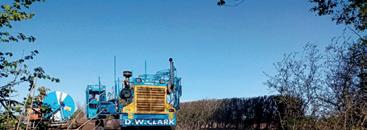


We put in around 170 metres of 225mm to the outfall as well as a 160mm main to “future proof” the system in case the client or his neighbour wanted to add to the drainage at any time. Once connected it only took a few minutes for the crater to start emptying. We took the drone shot the following morning and the crater was empty. Not a standard drainage job but interesting and quite fun to do.








Farmers attending this year’s Arable Event will be able to see for themselves how crops perform under ‘real world’ conditions with a host of trial plots.
Crops on show in the trial plots reflect the reality of modern farming dealing with changing climate and last autumn’s incredibly wet weather, which meant drilling was delayed until 30 October, said Wynnstay seed sales manager Joe Wood.
“This is representative and means that farmers can assess a varieties suitability to our increasingly challenging autumn conditions, the plot tours are definitely one of the highlights of the Arable Event, attracting a huge amount of interest from farmers.”
The plots are looked after by Wynnstay’s arable department. This year, they include a comprehensive selection of leading barley and hybrid barley varieties, oats, triti-
Afourth-generation farmer headed back to his old school to talk to teenagers about county food production, the countryside and farming careers.
Beef farmer Oliver Surman, of Upton on Severn, spoke to a 240-strong group of teenagers at The Chase School, Malvern, on Tuesday (20 May) in his role as an NFU Farmers for Schools ambassador.
The NFU Worcestershire chair said it was strange being back at the secondary school where he was a pupil in the 1980s and 1990s but he enjoyed engaging the next generation about food production and careers in agriculture.
Students were also encouraged to visit a farm with their families on Open Farm Sunday (8 June) and to consider taster days at some of the colleges in the area to get a feel for agricultural and horticultural careers.

Guided plots tours will help visitors assess and compare key varieties.
cale, hybrid rye and multiple top-performing wheat varieties.
Organised by Wynnstay and Grainlink, The Arable Event provides information to arable farmers ahead of the harvest and drilling season. As well as the trial plots, they will feature machinery demonstrations and informative and entertaining talks.
Plot tours hosted by industry specialists will give farmers a full and interactive overview of all market leading varieties, both new and old. Tickets are free and advance booking is recommended.
The Arable Event takes place on 18 June

off Offoxey Road, Weston Under Lizard, which is part of Bradford Estates on the Shropshire/Staffordshire border. Guest speakers will include farming YouTuber Olly “Blogs” Harrison.
Other expert speakers include Roy Jackson and Claire Smith, both rural partners at WR Partners, Joe Lloyd from the rural research team at Savills and industry experts Gareth Jones from FMC and Mark Tripney from LKAB.
Free refreshments are included and BASIS and NRoSO points are available to attendees. See www.thearableevent.co.uk

Almost one-in-ten farmers say they don’t have any internet, with 60% saying connectivity is crucial to running their farm.
The nationwide survey of UK farmers says bad or non-existent broadband connections are holding back the adoption of new technology on farms – including artificial intelligence and real-time monitoring capabilities.
Commissioned by CityFibre, the UK’s largest independent full fibre platform, the survey says access to full fibre broadband is encouraging the uptake of precision farming technologies with greater efficiency among the key benefits. Meanwhile, 9-in-10 farmers admit to avoiding using the internet during busy times of the day, causing disruption to daily schedules, especially
among family members who rely on the internet for other tasks, including education and hobbies.
The findings reinforce the importance of accelerating the rollout of full fibre internet in rural areas through government initiatives like Project Gigabit, which is delivering fast, reliable broadband to mostly rural.
Derbyshire dairy farmer John Chamberlain said he was relying on a 90-year-old copper line for broadband – but it was unreliable and his connection constantly went down, especially in bad weather.
NFU vice president Rachel Hallos (above) said: “To confidently produce more home-grown food we need to be as efficient and productive as possible. Reliable internet and mobile access are key to achieving this.”
When it comes to crop marketing, says Virgin Money Agricultural Director, Colin Aitkenhead, we can all learn from our shared experience.

Colin Aitkenhead, Director - Agriculture | M 07825 016286 | E colin.aitkenhead@virginmoney.com
The Value of Shared Experience When it comes to crop marketing, says Virgin Money Agricultural Director, Colin Aitkenhead, we can all learn from our shared experience.
As we head from Spring into Summer, I write this at the end of an almost completely dry April, another persistent weather pattern we would not expect from our traditional temperate climate.
In a period where there are already plenty of headwinds to challenge confidence and optimism, particularly for arable farmers and cereal producers currently, I am taking the opportunity to talk about crop marketing and its potential impact on decision making for the next 12 months.
There is still a sizeable number of farmers who have a fundamentally positive outlook, but with 80 years of subsidised food production now effectively at an end, it has never been more crucial to ensure that resources invested will yield some form of positive return.
Recent conversations highlight one point

of focus for me – marketing strategy! I am considering learnings from producers who have been working very closely to the free market and without material reliance on BPS/SFI etc.
For the pig, poultry, dairy, and horticulture sectors the proportion of BPS/SFI has been significantly lower for some time than for our arable and red meat producers. By nature, these sectors continue to be cyclical, but many of these enterprises have a laser like understanding of their cost of production and an agile grasp of their margins, overheads, and bottom-line profit per unit of production. As much as pig, egg, broiler and milk prices vary, these businesses adapt rapidly with market conditions.
Arable farmers also have this focus, but there is a much greater gap in the relationship between expenditure and market returns for your produce. The sectors above have a crop or produce to sell on daily, weekly, monthly basis, so cashflows are much more predictable and income is more immediately linked to production costs.
With potentially a two-year gap between commencing crop expenditure to when you sell, costs become very disconnected and if the market does not come back to you in Spring, then you can be exposed to added storage costs to compound the problem.



For cereal producers, preserving profits demands a marketing strategy that has to be adapted through the year, and this is where I feel focus could be better enhanced.
“Do I sell at harvest or later in the season?”… In some cases, storage is not possible or available and so this becomes a moot point, and over time selling off the combine becomes a default option where on average over time, you ‘do ok’.
As you head into harvest 2025, assuming that the crops are currently planted and awaiting some rain, it seems sensible to start making yield and input assumptions that would indicate where your breakeven point for each crop lies. As assumptions change this can be adapted through the season but will at the very least let you know if you are selling crops at profit or loss.
Of course, the ideal plan is to sell all the crop at the high point in the market, and I hope you do, but working from a known break-even price will make decision making easier, and limit risks of trading deficits. This is particularly important now there is less government support to insulate against a poor year, and a more conservative approach to marketing may be a better long-term strategy.
Every business is different and there is no simple template, but I am confident that using your professional advisors appropriately, and allocating time previously allocated to SFI/BPS will allow you to de-risk, or at the very least make better predictions and minimise the impact to your businesses in low return years.
Virgin Money have huge confidence in our food producers to adapt to what appears to be systemic change in our industry, and as a bank with over 180 years’ supporting in this sector, we base decisions on a long view.
As an agricultural financing specialist with 20 years’ experience, my role involves working alongside customers to help them consider the long-term impact of decisions. It is a privilege to provide experience-based advice to sustain the resilience and agility which I know will define the most durable enterprises over the next decade.

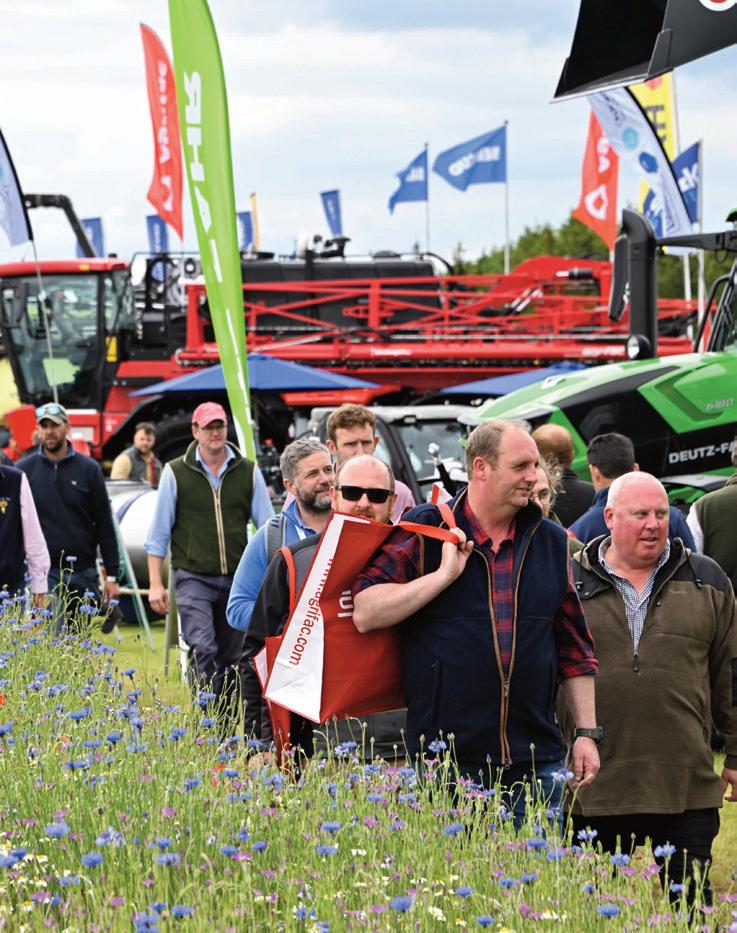
DTheUK'sFlagshipEvent rivingKnowledge& FInnovationinArable arming
Experience the ultimate event for the UK arable industry at Cereals.
Explore live demonstrations and dedicated zones for agronomy, technology, machinery, business, education, regenerative farming practices and SFI updates – all designed to help you grow your business andyour crops.
Connect with over 450 leading suppliers showcasing the latest innovations, products, and expert advice. From seeds to sprayers, crop varieties to cutting-edge equipment, and fertiliser to finance, Cereals offers a complete one-stop solution.
4Don’tmissthisunmissableopportunitytostayaheadinfarming! 20+ exhibitors|200+ livedemonstrations|600+ cropplots|60+ speakers|17,000+ visitors

• Lack of rain hits UK cereal crops
• Wheat and barley under stress
• Yield penalties on parched soil
Growers face an earlier harvest with combines expected to roll into cereal crops later this month after the driest start to spring for more than 60 years.
Reservoir levels remain low following the driest March in England since 1961. April received just half its normal rainfall – prompting some farmers to irrigate crops early, including cereals and sugar beet.
AHDB agronomy manager Emma Willis said: “Most cereal and oilseed rape crops were in fair, good or excellent condition at the end of April. A fortnight later and many more were showing signs of stress.”
With some wheat reaching flag leaf stage two weeks earlier than usual, growers on lighter land face an even earlier harvest than 2022, when combine harvesters rolled into barley before the end of June.
Martin Lines, of the Nature Friendly Farming Network, said: “Every day without rain pushes crop yields back-
wards. Water for irrigation is already running low, and farmers are having to make hard decisions about which crops – if any – can be saved.”
A meeting of the National Drought Group – convened last month by the Environment Agency – was told that water companies must do more to cut leakage and encourage customers and businesses use supplies wisely.
The drought group includes Met Office representatives, industry regulators, water companies, farmers and conservationists.
No area is currently in drought –but there is a medium risk this summer without sustained rainfall.
Chairing the meeting, Environment Agency deputy water director Richard Thompson warned: “Drier conditions at the start of this year mean a drought is a possibility and we need to be prepared.”
Farmers growing forage are being asked to assess feed requirements now because of continuing dry weather.
With many cattle and sheep farmers relying on grazing during the summer, and harvesting silage for winter food stocks, now is the time to make plans to help mitigate against poor grass growth.
AHDB senior knowledge exchange manager Katie Evans said: “The lack of rainfall – particularly in the driest regions where it hasn’t rained for weeks – could significantly slow growth, reduce silage yields, and impact grazing availability.”
Although good grass growth rates were achieved on some farms during early May, it was worthwhile farmers assessing both summer and winter feed requirements and building contingency plans, said Ms Evans.
“This might include reviewing silage stocks, being prepared to cut earlier than usual to prioritise feed quality over bulk and considering fastgrowing catch crops for summer or autumn grazing.”
“Rotational grazing can help protect residuals and reduce plant stress, and where pasture supply is tight, using buffer or supplementary feeding early can protect sward recovery later in the season.”
Small decisions now would help to maintain long-term resilience and avoid bigger challenges later in the year, said Ms Evans.
“It’s about being proactive: resting paddocks, avoiding overgrazing, and preserving pasture cover. ”
as working with farmers to help them plan for irrigating their crops.
Above: An old bridge is revealed at Baitings reservoir during the 2022 summer drought
The last two years were some of the wettest on record for England, acknowledged Mr Thompson. But he added: “The changing climate means we will see more summer droughts in the coming decades.”
The Environment agency said it was closely monitoring the situation – especially in high-risk locations – as well
Defra water minister Emma Hardy said: Our water infrastructure is crumbling after years of under-investment. Water companies must go further and faster to cut leaks and build the infrastructure needed to secure our water supply.
The government had secured over £104 billion of private sector investment to fund infrastructure improvements, said Ms Hardy.
This included nine new reservoirs to secure future water supply into the decades to come, she added.
Growers seeking to achieve protein specification in milling wheat are being reminded to optimise nitrogen without overstepping economic thresholds.
Modern wheat varieties have huge yield potential, but growers must be realistic about whether these can be achieved on their own farms, say two advisers from agronomy company Hutchinsons.
A well-timed application of nitrogen after the flag leaf final-dressing will increase the amount of nitrogen available to crops during that crucial stage of protein development, says crop nutrition manager Tim Kerr.
Without a well-timed late application of nitrogen, crops may struggle to contain enough protein to satisfy yield and quality requirement. The later this dressing is applied then the more influence it will have on grain protein up to ear emergence.
Taking a Group 1 milling wheat targeting a protein threshold of HFN250, Mr Kerr and farm business consultant Leo Page say growers should pose three pivotal questions around late season nitrogen requirements.
1. What is the likelihood of achieving milling wheat spec?
This is an important starting point and should be based on the historical success of meeting milling spec weight with a particular variety. If regularly or even occasionally achieved, then it would be sensible to follow past nitrogen fertiliser strategies.
If not, don’t apply additional nitrogen, it doesn’t make economic sense. Recommendations also shift with low spring rainfall. If the weather stays dry, later applications of foliar urea at the milky ripe stage will become more important.



2. Should I then consider a late nitrogen application to push for protein?
Use the protein prediction test to decide whether a late application of nitrogen is needed. Hutchinsons have been using this test since 2019 and Andrew Pitts at Helix National farm uses it routinely for his milling wheat samples.
The test involves digging up 5-10 wheat plants from across a field and then sending off to the lab. Samples can be taken from third week in May onwards. The test retails at £36.50 per sample.
3. How can I calculate the effect of more nitrogen on my break-even costs while accounting for uncertainty and volatility?



Be aware that some milling contracts prohibit the use of foliar urea. Instead, consider forms of methylene urea applied with the T3 fungicide which is now a well-established practice. It is crop safe and reduces the need for extra field passes.










Milling wheat requires about 5kgs extra N/tonne of wheat – so a 10-tonne milling crop needs circa 50 kgs extra N than the equivalent feed wheat crop.






Taking into account the reliability of achieving milling spec and the fertiliser product bought, this is an additional variable input cost of £5-6.50/tonne of wheat. This is money well spent when the crop is sold for an additional premium. milling



Recommendations shift with low spring rainfall. says Tim Kerr































uesday 17th June, 12pm to 3pm

ome along to see how different winter wheat varieties are faring in 2025, and to discuss your arable crop, weed, and disease concerns with ADAS and AHDB specialists.












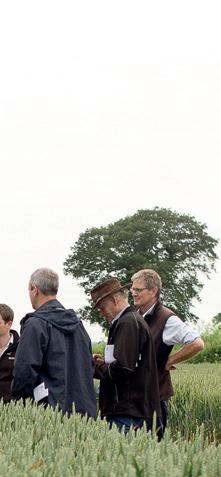



















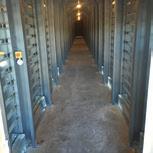





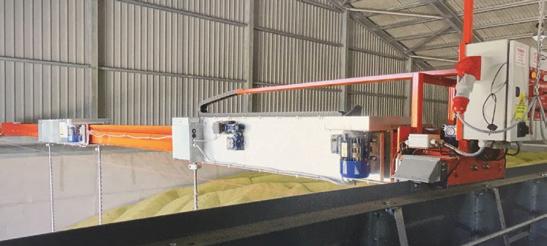


















Popularity is increasing among growers after an influx of new varieties from breeders
Abreeding revival in both Group 3 and soft Group 4 sectors is helping soft wheats make a comeback on farms.
Back in the day, nearly 50% of the UK wheat area was down to soft wheat varieties – including Claire, Riband, Robigus and Consort. But the percentage declined as those varieties fell out of favour – with only 8% of the total area growing soft wheat in 2024.
That should change with new varieties making soft wheat growing much more attractive again, believes Clare Leaman of NIAB. “We’ve had many years of new biscuit wheats coming, but none of them were a step forward in yield,” she explains.
“And there was such a big gap between them and hard feed wheats, with only a small premium available, that there wasn’t much incentive for growers unless you farmed very close to a biscuit mill.
“That’s now changed with the likes of Bamford, KWS Solitaire and KWS Flute because the yield of those varieties has jumped to be competitive with hard feeds and opens opportunities to a wider range of growers.”
quiring changes to agronomy. Distilling, milling and export markets are all possibilities, depending on location, says Ms Leaaman, albeit at relatively small premiums compared with traditional Group 1 milling wheat.
“Any premium is a bonus, even if you’re not growing it specifically for a market.”
Soft wheat premiums for last year’s crop have been particularly attractive for the past few months, according to soft wheat grower Sam Morris, who has been receiving £28-£30/t, rather more than the typical £10/t.”
Relative scarcity
Part of the explanation for the higher premiums lies in the relative scarcity of soft wheat alternatives, says Mr Morris, plus last year’s challenge with protein content. “This year is almost certainly going to be an outlier, but it’s been welcome.”

tor broke down to septoria as the ‘Cougar’ gene lost its effectiveness.
Market acceptance for a variety from the mill is a key requirement in his variety choice, along with yield. But he will also look at other characteristics to fit his system.
“Our rotation is three wheats on the bounce followed by a double spring break of spring barley and spring beans, which we find works well. So I’m looking for relatively high yielding second and third cereals.”



It’s not just Group 3s which have improved. options for soft Group 4 feed wheats are also keeping pace with hard feed wheats, with the likes of RGT Hexton and LG Redwald all but matching the top-performing hard feeds, such as Champion and LG Beowulf.




Mr Morris, who farms near Royston in Cambridgeshire, has been a long-term soft wheat grower, after switching away from Group 1, when the challenge and higher risk associated with making breadmaking specification became




The beauty of soft wheats lies in the additional market opportunities, without re-










Relatively close to a Whitworth Bros mill near Wellingborough, the typical premium was enough to keep the farm growing soft wheats even through recent difficult years when most of the sec-



He’s also happier to see varieties with better disease profiles available again, following the struggles with septoria.”
Another new variety is soft Group 4 RGT Hexton. It has many attributes, says Mr Morris. “We have a small block of Hexton in one of our fields to see how it performs.”

Clare Leaman: The latest soft wheat varieties have much to offer


Hexton is the top yielding second wheat on the recommended list at 108% of controls. RAGT arable technical manager Andrew Creasy says the variety is very competitive, scoring 105% across all trials.


• Think about sulphur – not only nitrogen
• Nutrient efficiency at heart of decisions
• Consider decoupling for more flexibility
Growers and agronomists are advised to think more broadly when devising their fertiliaer plans for next season.
A wider view when it comes to or ganic and inorganic fertilise will ensure crops get the right nutrients, says Pe ter Scott, technical director at Origin Soil Nutrition.
The need to reduce the carbon foot print of food production and minimise potential environmental issues, means growers need to understand more than ever how to low carbon fertiliser prac tices, he believes.
“Use of inorganic nitrogen fertilis ers is the single largest component of the carbon footprint of crop produc tion and any attempt to decarbonise food production will need to address this.”

In a typical combinable crop, 50% of the carbon footprint is related to the production of the fertiliser in the first place and the other 50% is due to in-field emissions.
“But, around half of human die tary protein consumed globally is di rectly related to the use of inorganic nitrogen and in the west, this would be much more. The issue of nitrogen use goes to the very heart of sustain able food production.
“Green ammonia, where the hydro gen element of ammonia comes from water rather than gas, could play an important role in the future with re gard to reducing the carbon footprint of manufacture, but we must also ad dress in-field emissions.”
Nutrient efficiency
The pH of soil together with its organ ic matter content and structure plus other considerations such as drain age all impact on emissions, so better management is essential in the future, says Mr Scott.
“One of the biggest things we can do, and one of the most important






























Poor trailer safety is being highlighted as a key contributor to farm fatalities during the busy harvest period.
Farmers and harvest workers are being urged to undertake daily checks and ensure tractors and tailers are well-maintained.
Trailers should also be serviced and in good condition well before what is one of the industry’s most dangerous times of the year.
“Good preparation leads to an efficient and professional business,” says Jane Gurney, of the Tilly Your Trailer safety campaign.s.
Of 27 people killed in farm accidents last year, nine deaths related to transport, including farm vehicles or machinery, runover incidents, rollover incidents and crush incidents.
Bob Henderson, of rural insurers NFU Mutual, said: “It’s vital to make sure that machinery is kept well-maintained and that staff have the skills and the training to do their job safely to avoid accidents and breakdowns.”
Many farmers inspect kit only when the weather is bad. But regular maintenance checks on brakes, tyres, trail-
“ Visibility on the road is important
as a good guide to the minimum wear on a towing eye
Visibility on the road is important to make other drivers aware of your presence, says Ms Gurney. This is especially the case during the busy season and with bright lights and shadows obscuring vehicles and gateways.
Turning on to the road with front weights and bale chutes should be a particular concern, as these protruding have led to catastrophic crashes. Side marker lights and reflective tape are available and increase visibility.
Amber flashing beacons should be visible for 360° in a horizontal plane. Many trailers have an amber beacon, which should always be used where the trailer obscures the light.
When strapping a load onto a flatbed trailer, correctly rated lashing straps in good condition should be used, not ropes. Straps should not be frayed or worn – and sufficiently rated to the weight of the load.
For a full checklist of trailer safety checks, visit www.tillypass.co.uk

Sheeting
Flashing beacons and lights
Understand your trailer speed and weight limits







Is game changing wheat
Bamford still changing the game? Four experts give their verdicts.
Now in its second year on the Recommended List, Group 3 soft wheat Bamford came through a challenging first full commercial season in 2024.
Bred by Elsoms Seeds, the first year was dominated by serious outbreaks of both septoria and brown rust, as well as tough autumn establishment conditions. So has the variety continued to live up to its hype?
Clare Leaman, NIAB cereals variety specialist
It’s no exaggeration to say that Bamford has revitalised the Group 3 sector and has made the variety decision for many growers who moved over to hard Group 4 feeds a much more difficult one now than in previous years.
To see a Group 3 of Bamford’s overall quality is very welcome, and something we haven’t seen for some time. On agronomics, it has a high, competitive untreated yield –offering a good specific weight and a solid overall disease resistance profile.
Joe Wood, Wynnstay Group seed manager
Farmers in the west often encounter very different climatic conditions to growers in the east –including higher rainfall that often results in heavy septoria pressure.
Our customers need varieties with solid disease resistance scores supported by a high untreated yield knowing that key sprayer timings may not always be met

With an untreated yield of 90% Bamford ticks that box. And with a treated yield of 107% in the west, it offers a higher potential yield than virtually all the current Group 4 feed wheats.
As most of our customers are mixed farmers high straw yields are critical, and, with many of them rolling their own grain on-farm, a bigger, bolder grain such as Bamford’s is much more desirable than a smaller pinched grain.

Bamford has wide marketability and there were no red flags during a challenging 2024 growing season – so it’s absolutely up there. That said, 2025 is another big year and I think growers will know a lot more by next harvest.
Although I recognise and respect Bamford’s wide marketability, most of our customers are growing for feed so the emphasis is on yield and how easy the variety is to manage on fields that are often difficult to travel on.
Wheat varieties grown in the west need to be flexible and straightforward to manage, tiller well and, most importantly, not fall over. Bamford has also fully justified its solid scores on resistance to septoria and brown rust.
Ian Davy, national seed sales manager, Agrii Bamford achieved an overall treated yield of 110% to controls in Agrii trials across eight regions last year. On untreated yield it achieved 89% across the 8 trials, very much in line with its official RL rating.
With solid agronomics, a wide drilling
window and exceptional competitiveness, which enables it to compete against difficult grass weed burdens, it offers growers the triple reassurances of high yield, good quality grain and multiple end markets.
Bamford sold well with high demand coming from virtually every UK region, something which is not always the case. It’s one of our top five best-selling varieties.
Regardless of classification, Bamford is a great winter wheat in its own right and I see no immediate reason for its current popularity to diminish.
David Bouch, head of seed, Hutchinsons Bamford is delivering yields that are as good – if not better, than all the Group 4 feed wheats, holding its appeal and looking set to gain more area with an increased market share.
It’s arguably one of the best winter wheats on the current RL, regardless of classification, and is still a game changer for first-time growers who have only just begun successfully incorporating it into their rotations last autumn.

It can be grown as either a first or second wheat, performs well on all soil types, and during a very bad year for both septoria and brown rust its disease resistance held up very well from customer reports we’ve received.


Grain cooperative Camgrain says it remains well-placed to remove ergot from cereal crops this summer – after winning praise for the way it helped growers deal with the problem last year.
The farmer-owned storage and processing facility invested some £500,000 in colour-sorting machines after ergot made an aggressive comeback during the 2024 growing season which brought ideal conditions for the fungus to thrive across the UK.
Many farmers found themselves facing unprecedented levels of ergot contamination. The black, hornshaped fungal bodies – toxic to both humans and livestock – meant thousands of tonnes of grain risked being downgraded or rejected outright.
Caused by the fungus Claviceps purpurea, ergot infects the flowering parts of cereals and grasses, replacing grain with dark sclerotia.
“It was a brave and proactive move
The presence of ergot renders grain unsafe for consumption if left uncleaned. For arable producers, it’s not just an aesthetic issue – it’s a food safety concern. Ergot is toxic and its presence results in severe financial penalties and rejected loads.
Stark challenge
With grain arriving at Camgrain stores showing contamination levels rarely seen in recent decades, the chal lenge last harvest was stark: how to clean large volumes of affected crops without passing the cost of losses back to farmers.
Camgrain chief executive Simon Willis says: “Ergot was present in about two-thirds of all wheat intake – and at unprecedented levels.
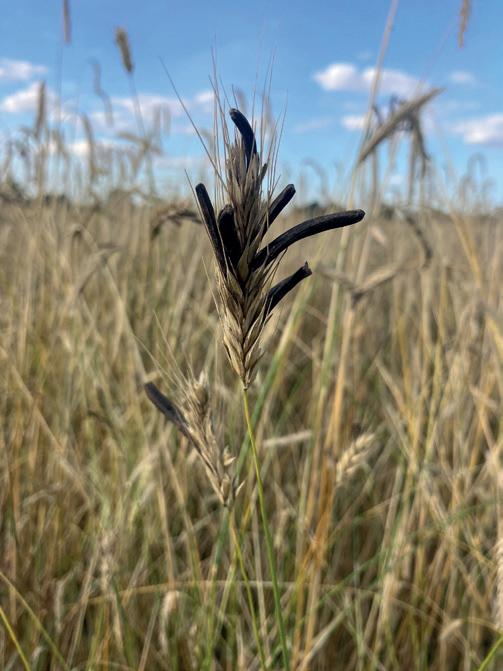
“If you calculate and consider that just five pieces of ergot found in a 1kg sample represents 145,000 pieces of ergot in a standard 29t lorry load, then
going to support members and maintain food-grade standards. So, we made the call – early and bold.”
Camgrain placed orders for two Cimbria CTN7 colour sorters – and









































































built a brand-new colour sorting facility at its busiest site in Balsham, Cambridgeshire. The co-op also invested in a fully mobile colour sorting rig for its sites in Kettering and Stratford-upon-Avon.
“It was a brave and proactive move,” says Mr Willis. “If we’d waited, lead times for the machines would have gone through the roof – we’d probably still be waiting for them now.”
Commissioned in January 2025, the new plant brought Camgrain’s total cleaning and colour sorting capacity to over 150 tonnes per hour.
It couldn’t have come at a better time, says Dan Parrott, Camgrain’s head of operations. “We’ve seen more ergot than anyone in the business can remember,” he explains.
“We had to move to 24/7 operations at our East Anglian sites to stay ahead—sorting, cleaning, and removing ergot continuously since harvest.”
The Cimbria CTN.7 machines have exceeded expectations. Designed for high-throughput environments, they use advanced optical sensors to detect and remove contaminants at speed,


without damaging the grain.

Camgrain not only to process ergot-affected grain rapidly but also to reduce costs for its growers in the process –with any operating surplus returned to Camgrain members.
“Because of the speed and success of the new system, we’ve been able to reduce colour sorting charges significantly,” explains Mr Willis.
“Starting with Harvest 2025, our standard member rate for colour sorting will be just £4 per tonne.”
For the 2024 season, where higher sorting charges were initially neces-



Camgrain’s timely investment paid dividends for arable growers
sary to recover costs, the co-operative expects to return any surplus directly to members in the form of an exceptional payment this autumn.
“It’s simple: our members are our shareholders,” says Simon. “Any profit we’ve made from helping them remove ergot will be redistributed fairly. That’s the co-operative model working as it should.”
Ergot remains a persistent threat. As climate conditions continue to shift, the frequency and severity of outbreaks could increase.
However, proactive strategies like those deployed by Camgrain help to safeguard both farm businesses and food supply chains.
Looking ahead to harvest 2025, Camgrain’s investments ensure that members will not face the same financial burden should ergot strike again.
The infrastructure is now in place, and the business has shown that rapid, decisive action can pay dividends, says Mr Willis. “We hope for everyone’s sake that this year’s crop is cleaner,” he adds. “But if it’s not, at least we’ve built the capability to deal with it.”

of








The
GAC
hand-held has proved to be the UK’s most accurate moisture meter. Consistently proving its accuracy and reliability using the lasest 149MHz technology and is cheaper than similar UK models.
The Mini GAC 2500 hand-held has proved to be the UK’s most accurate moisture meter. Consistently proving its accuracy and reliability using the lasest 149MHz technology and is cheaper than similar UK models.




Developed in 1983 by a group of farmers, Camgrain provides a reliable, safe and secure co-operative grain storage facility to our farmer members.
Developed in 1983 by a group of farmers, Camgrain provides a reliable, safe and secure co-operative grain storage facility to our farmer members.
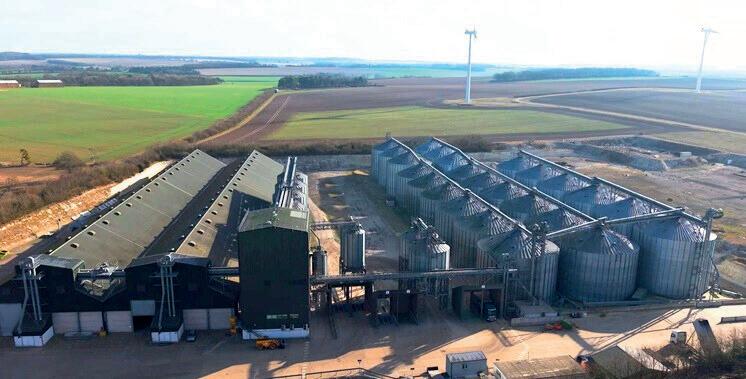


Looking to diversif y your farming assets and need somewhere to store your grain?
Looking to diversif y your farming assets and need somewhere to store your grain?
We can help with Industry beating drying, conditioning rates and ergot removal enabling access to premium markets.
We can help with Industry beating drying, conditioning rates and ergot removal enabling access to premium markets.
New flexibility on short term storage
New flexibility on short term storage
New flexibility on short term storage
2025 Annual storage + Handling now £9.90 p/t Competitive drying charges
2025 Annual storage + Handling now £9.90 p/t
Competitive drying charges
Competitive drying charges
Reduced Ergot cleaning charges now from £4 p/t
Reduced Ergot cleaning charges now from £4 p/t
Reduced Ergot cleaning charges now from £4 p/t
Arrange your own harvest haulage or pay actual cost to your closest store
Arrange your own harvest haulage or pay actual cost to your closest store
Arrange your own harvest haulage or pay actual cost to your closest store
Special ‘of f peak of fer’ to deal with remaining crop on farm with Ergot issues
Special ‘of f peak of fer’ to deal with remaining crop on farm with Ergot issues
Special ‘of f peak of fer’ to deal with remaining crop on farm with Ergot issues
Please contact the Membership team on 01638 57 2800 option 0 or email us at memberservices@camgrain.co.uk to see how we can help you.
Please contact the Membership team on 01638 57 2800 option 0 or email us at memberservices@camgrain.co.uk to see how we can help you.
Please contact the Membership team on 01638 57 2800 option 0 or email us at memberservices@camgrain.co.uk to see how we can help you.
We proudly serve farmers producing: Wheat | Oilseed Rape | Barley | Oats | Linseed | Rye | Beans | Peas | Organic Crops Join hundreds of like-minded farmers and future-proof your business with Camgrain
• Auto-drying with remote alert
• Quieter, cleaner and efficient
• Easier to use and to maintain
ABedfordshire grower is reaping the rewards after replacing an ageing PTO-driven grain dryer with a state-of-the-art mobile machine.
Sandy Wade-Gery, who farms with son Will at Bushmead Farm at Colmworth, near Bedford, installed a new automatic electric Mecmar SSI 28T mobile dryer, supplied and supported by McArthur BDC.
“Our old mobile dryer was reaching end of life and we needed to upgrade to an automated solution providing larger capacity and improved energy efficiency,” says Mr WadeGery, who grows some 400ha of combinable crops.
The Mecmar SSI 28T stood out for its build quality and its ease of use, particularly the remote access capability of the dryer’s control panel, which sends an SMS notification to the operator when the dried grain is ready to be discharged.
Quieter drying
“There is no longer the need for the operator to be constantly monitoring the dryer,” said Mr Wade-Gery. “The old dryer tied up a tractor and the burners were driven by gas from a bulk tank. It was noisy, and dusty.”
The new electric Mecmar uses diesel from an onboard tank to power the burners. It is super-quiet and has an integrated dust extraction system –two features which mean it sometimes can’t be heard working.
The old dryer was precarious and difficult to maintain, whereas the Mecmar is much easier to look after as the
grease points are positioned in one central location beside the control panel.
The Mecmar dryer is fully automatic, streamlining the entire drying cycle. From the field, grain can be tipped directly into the loading auger from the trailer. It can also be loaded with a telehandler via a portable hopper placed over the loading auger.
Using the Mecmar’s control panel which has pre-set drying programmes, configured by the operator at the beginning of harvest, the correct programme is selected so grain is dried precisely to the required moisture content.
Once set, the grain is automatically fed from the intake hopper to the Mecmar and as soon as the mid-level sensor located inside the dryer is covered, the fan and burner starts and drying begins.
When the high-level sensor is covered the loading auger stops automatically. As the grain recirculates within the dryer, the Mecmar’s aspirator, located at the top of the central auger, removes dust and chaff, improving the bushel weight of the crop.
Once grain reaches the target temperature, the dryer then enters a predetermined cooling cy-cle. Once cooled, the Mecmar’s integrated moisture content meter checks the grain to deter-mine that it is at or below the pre-selected target moisture content.
If the moisture check is correct, grain is then automatically discharged.
When the low-level sensor is uncov-

ered and the dryer is empty, the loading auger automatically starts, feeding grain into the dryer so that the next batch begins – making the drying process as timely and as efficient as possible.
When the operator receives a notification from the control panel that the grain is ready to unload and, if a trailer is in place, he allows grain to be discharged and taken to the store.
“The Mecmar is light years ahead of our old dryer,” says Mr Wade-Gery.
“We wanted a dryer that delivered an auto-mated solution, was efficient, quieter, reliable and would meet our drying requirements well into the future,” he adds.
“McArthur’s support, which was a significant factor in our choice of the Mecmar, has been excellent and the whole system fits perfectly with our forward-thinking approach to farming.
“To keep moving forward we are looking at relocating the Mecmar into a dedicated grain store and adding a colour sorter to further enhance how we process our grain”











With all eyes on crop performance in the field, now is the time for Arable Farmers to prioritise grain store pest protection ahead of harvest 2025. Month’s of hard work can be undone by a hidden pest infestation or missed treatment - compromising grain quality, safety and impacting the market sale value.
Ken Black, Envu account manager, warns: “Insect control is no longer optional. Milder winters have removed the natural chill that kept pests at bay—now, insect pressure in storage is rising fast.”

Historically, colder winters acted as natural pest control mechanisms, however the new normal of milder winters are removing one of the natural factors that previously helped reduce pest pressure in grain stores. This shift means farmers must compensate with proactive treatment strategies to limit insect activity and lifecycles. Despite all the hard work growers put into cultivating crops, poor grain store preparation can lead to significant losses during storage.
Ken comments “Grain storage preparation is often the missing piece of the growing season jigsaw, but insect damage in stores can result in losses comparable to pests and diseases in the field. If you don’t get the storage environment as clean and insect-free as possible, you risk undoing all that effort.”
Grain stores should be cleaned out 6-8 weeks ahead of harvest. Remember to:
• Remove dust, debris and old crop residue
• Clean all machinery and handling equipment – even the combine!
• Access all hard to reach areas including roof spaces, underfloor voids, wall junctions, nooks & crannies
• Use insect monitoring traps to assess pest levels


Check every 7–10 days. If pests are present—as is often the case—a grain store protectant should be applied across all surfaces.

One of the most effective treatments for grain stores ahead of harvest is K-Obiol® EC25 exclusive to Lodi UK. Designed for application after cleaning and before new grain is stored, K-Obiol EC25 provides broad-spectrum protection against both primary and secondary storage insects. With up to two months of residual activity, it targets:













SAW TOOTHED GRAIN BEETLE GRAIN WEEVIL



WEEVIL LESSER GRAIN BORER









While K-Obiol EC25 handles structural protection, pairing it with K-Obiol ULV gives full-circle protection by treating the grain itself as it enters the store. This dual defence approach, treating the structure and the crop, provides peace of mind, safeguarding your yield, your revenue, and your reputation. At Lodi UK, we’re committed to supporting farmers with trusted grain storage solutions that are practical, reliable, and backed by years of success in the field.
Contact Lodi UK for advice on application, availability, and how our K-Obiol products can become the most important part of your pre-harvest preparation.



• Dry spring slows crop growth
• Many crops at different stages
• Strategic approach to weeds
Lack of rain continues to create challenging conditions for sugar beet – with hot weather adding to the challenge of what and when to spray for weed control.
While the dry weather helped growers expedite drilling, with most finished by the end of March, it has slowed crop development and left plants at different growth stages, says UPL head of technical services Stuart Jackson.

“Continuing dry weather coupled with relatively high temperatures is leading to – in some cases – stressed, variable crops and difficult conditions to achieve successful weed control,” he says.
“It’s not in every situation. Where growers were able to get a good seedbed, drilled a little earlier, crops are generally looking healthy, and weed control has been good.”
Drought stress
Emerged weeds are generally pretty tough to control because they are waxed up and drought-stressed, adds Mr Jackson. In these scenarios, we need to load more contact activity into programmes.

“Typical residual mixer partners, such as Venzar (lenacil), are less effective in dry soils, where root uptake is restricted, and should be replaced by more contact-acting herbicides.”
“For example, you can look to add products such as Shiro (triflusulfuronmethyl) and/or Vivendi (clopyralid) to base mixes of Betasana (phenmedipham), plus Bettix Flo (metamitron) + Efeckt (ethofumesate).
A diligent approach is always best for sugar beet weed control
Tank mixes
Adding oil to herbicide mixes will help pep up weed control, but it can come at the cost of crop safety. Use the forecast maximum temperature on the day of application to help guide decisions, with anything over 21ºC as the cutoff for not adding it into tank mixes.
Where growers want to use oil at their own risk in temperatures above 21ºC, rates should be cut to no more than 0.5 litres/ha and spray first thing in the morning or the evening, says Mr Jackson.
(flupyradifurone), all of which are compatible with the three-way mix of Betasana, Bettix Flo, and Efeckt.
“What we don’t know yet is the compatibility of Sivanto Prime with the bigger multi-way mixes where you add in Shiro or Vivendi. Insyst or especially Teppeki are better options if you’re looking to do that type of bigger mix.
“Obviously, you also need to consider advice around the sequence order of the insecticides, which says to avoid using two sprays with the same mode of action in a row.




“Shiro will be helpful on polygonum weeds and brassicas, while Viven-







“If crops have flagged or flopped during the heat of the day, avoid spraying in the evening and leave them until the morning.”





Depending on that, it may be the case of spraying the weeds first, waiting for a few days before spraying the insecticide to give more flexibility.

With aphids arriving earlier than originally forecast at the beginning of May, many growers might need to tank mix an insecticide with their weed control spray.


“If you are tank-mixing an insecticide, don’t add oil. However, it may be worth replacing the oil in these conditions with a biostimulant like Vitalroot to help the crop thrive.

The three insecticides available for use are Teppeki (flonicamid), Insyst (acetamiprid), and Sivanto Prime




are important
Vitalroot is seaweed extract with phosphorus and potassium. It can be used at 1-2 litres/ha in conjunction with a broadleaf spray programme.
It won’t pep up herbicide activity like an oil, but it will help with crop growth,” concludes Mr Jackson.










The correct pH builds your soil’s fertility:
• Improved nutrient use efficiency
• Creates the ideal conditions for soil microbes to thrive
• Calcium enhances soil structure and root development
Speak to our expert team about LimeX
Customer service 0800 090 2376










Highly recommended for all regions of the UK, this topperforming conventional variety boasts the highest yield. Featuring large pods and abundant seeds, it ranks as the No.1 choice. Developed in Britain specifically for British farmers, its superior yield, vigour, and establishment surpass even that of Campus.

• Nutrient uptake in dry conditions
• Alternative to artificial fertilisers
• Helps crops reach yield potential
More growers are treating beet crops with nitrogen fixing bacteria biofertilisers to ensure plants have essential nutrients available during key growth stages in dry weather.
Early season applications of Vixeran lock nitrogen fixing capabilities into the plant and the soil biosphere through the growing season – even in dry conditions, says Syngenta technical manager Andy Cunningham.
Early nitrogen has been identified as especially important for the formation of a strong green leaf canopy in sugar beet. Vixeran applications are seen as a good alternative where artificial fertiliser uptake is compromised.
Sugar beet plants benefit from biofertilser availability in dry conditions
Inset: The target is to have sufficient leaf area, says Andy Cunningham
Recent trials in Holland found that a single Vixeran application at the five to eight leaf stage in sugar beet, delivered a 4 t/ha yield increase and 0.7% improvement in sugar content over a standard140kg N/ha fertiliser input.
Applied before the crop covered the ground, the trial also demonstrated that Vixeran could more than compensate with decent yield and sugar content when the artificial nitrogen was reduced by 40kg/ha.
The specific endophytic bacteria strain of Azotobacter salinestris in Vixeran has been selected to work in typical weather conditions in the UK and northern Europe, as well as improving resilience against climatic extremes.
Trials have shown that the optimum timing for application in sugar beet is at the four to eight true leaf stage (BBCH 14-18), says Mr Cunning-
ham. In potatoes, it is around the onset of tuber initiation.
“The target is to have sufficient leaf area for uptake into the crop, but also where spray can reach the soil and colonise the root zone with the nitrogen fixing bacteria, which will convert atmospheric nitrogen into available nutrient for the plant.
“That’s essential when the crops are going through rapid vegetative growth and setting the all-important yield potential for root development.”
With some areas receiving just 5-10% of average rainfall during March and the first three weeks of April, particularly in the primary root crop areas of eastern England, nutrient availability of applied artificial fertiliser was seriously limited.
Soil temperatures in most areas remained optimal for Vixeran biofertiliser activity, which quickly starts to generate readily available nitrogen to match crop growth – even in dry conditions, says Mr Cunningham.
For ease of application, Vixeran is tank-mix compatible with Priori Gold/ Angle disease control in sugar beet –and with blight fungicides including Revus and Evagio Forte in potatoes.
Viceran can also be applied at the same timing with Quantis biostimulant, to manage temperature stress in both root crops.



























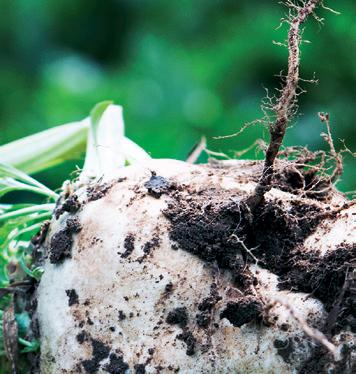
















Sugar beet growers looking to rationalise herbicide use should consider the pros and cons of alternatives – which may not suit all situations and seasons.
British Sugar’s weed specialist and technical support manager Pam Chambers has been testing different weed control strategies at a site in Yaxley, Suffolk, for two seasons.
The inspiration for the work is the threat of herbicide withdrawals and the need to reduce reliance on chemistry, she explains.
Big losses include the loss of des-
there is no one easy, standalone solution for growers, and we need to make this known to both regulators and NGOs to ensure we keep those valuable tools.”
Going into detail about the Yaxley work, Ms Chambers and her team has been testing a range of weed control options available today, including traditional herbicide spray programmes..
The Conviso Smart system, which was designed to use ALS herbicide tolerant beet to control weed beet and re-

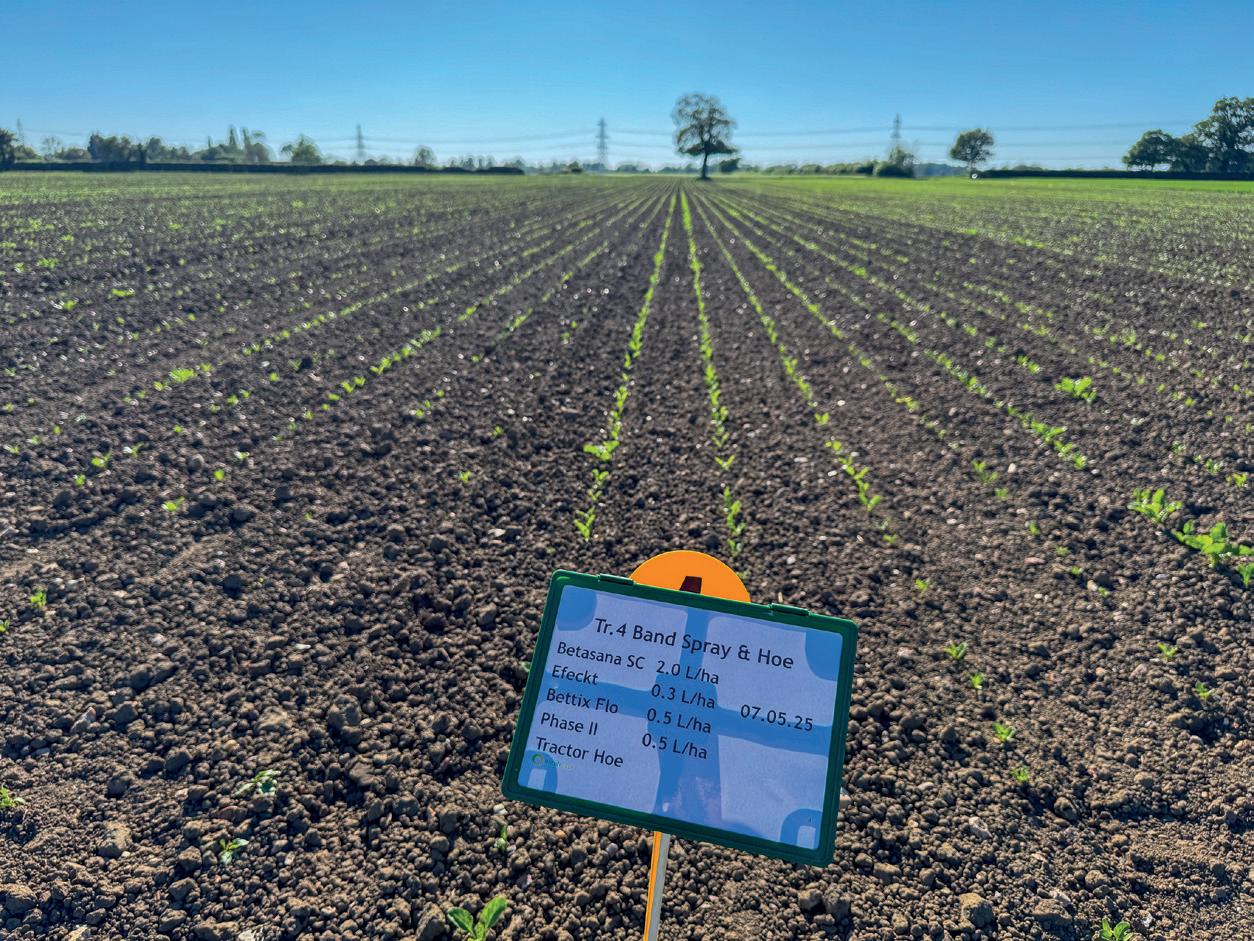
Clockwise from above: The Yaxley trials site; the Ecorobotix spot sprayer; Pam Chambers
timed when trigger weed fat hen reaches four true leaf stage.
This led to some weeds being left behind and means an additional follow up spray will be required and this
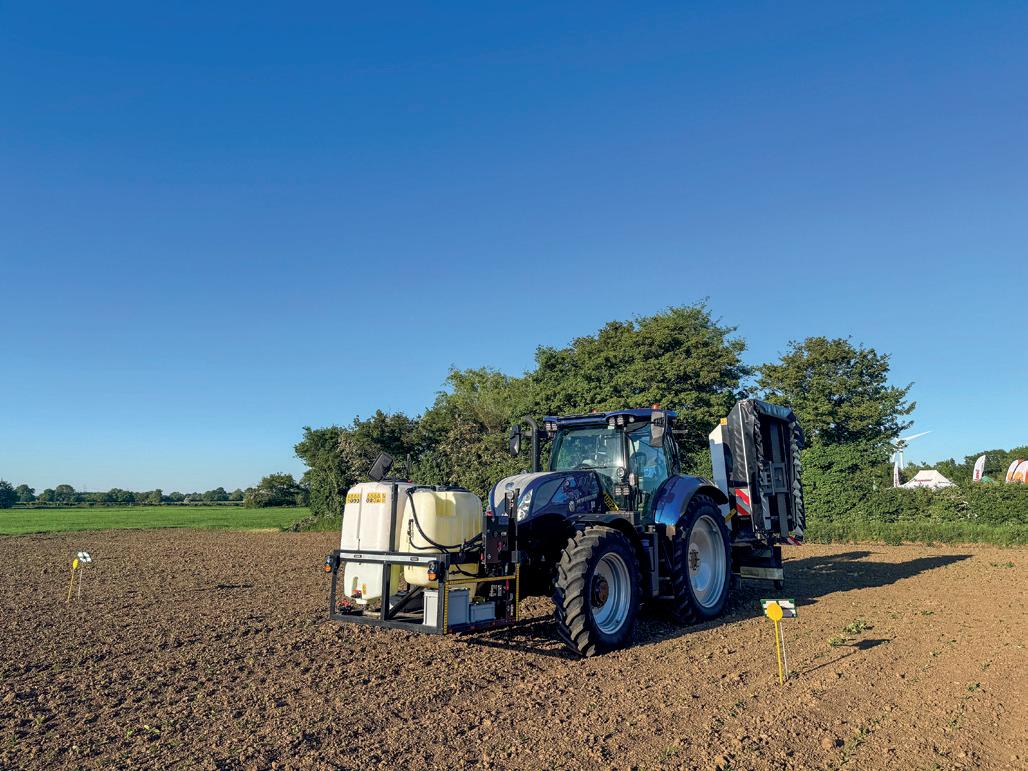

cons too. Plots treated with the mechanical hoe only has left plenty of Chenopodium species like fat hen within the row this year, which would need to be tidied up with herbicide.
Finger wheel attachments may help improve in-row control, but it’s likely an additional herbicide would be needed to avoid significant yield loss from weeds left behind.
A Lemken tractor hoe and band sprayer combination was added to treatments this year and Pam was impressed with its overall efficacy both between and within the crop rows.
“There is no easy, standalone solution
But this combination requires significant investment, even with grant funding, and would be most viable where it can be used in other arable or horticultural crops across a rotation.
“Hoes with or without a band spray-
er have the potential to reduce reliance on blanket herbicide application, but work rates are relatively slow.
“In a wet year, large growers may struggle to get across their area and weed control is not as good as when its dry, so either system would still require backup,” says Ms Chambers..
Results with the Ecorobotix have been promising so far, but with a price tag of about £130,000, individual sugar beet growers will struggle to justify the investment.
But growers and contractors are already making it work where high-value crops like onions are in the rotation and there are examples of local groups sharing the upfront cost.
“It uses significantly less water and chemical,” she says. “But I suspect in fields with a very high weed burden, you would need to apply a pre- or early post-emergence to with a conventional sprayer to reduce numbers before switching to an Ecorobotix.”
Ms Chambers urges growers to really understand the strengths, weaknesses, and economics of each before taking the plunge.


The earliest understanding of ‘Beet Yellows Virus’ (BYV) goes back c.90 years, but it wasn’t until the early 1950’s that the aphid species responsible for transmitting the virus were identified.
Since that time and up to the early 1990’s, controlling aphids with foliar insecticides was our primary line of defence against a virus that had the potential to reduce yields by almost 50%. Again in the 1950’s another less yield impactful virus was identified that we know as ‘Beet Mild Yellows Virus’ (BMYV). In the 1980’s to 1990’s a new virus was discovered, formally named ‘Beet Chlorosis Virus’ (BChV) in 2002, giving us the three virus complex we face today.
The ability for the aphid population to adapt and develop almost complete resistance to insecticides was of significant concern and therefore the introduction of neonicotinoid (NNI) seed treatment offered growers and the sugarbeet industry almost season-long aphid control. The ban on this chemistry from 2019 due to environmental concerns left a void that returned us to foliar insecticides requiring frequent crop inspection to support timing based on aphid threshold.
The very high incidence of virus yellows in 2020 was valued at over £65M, equivalent to c.25% yield loss; leading our industry to seek Emergency Authorisation to use NNI on a risk managed basis using the Rothamsted Research model. This successfully permitted the use of NNI seed treatment between 2022 and 2024 with c.60% uptake each year. Now looking to the immediate future, aphicide sprays and varietal tolerance will be our defence options.
Anticipating that the reliance on NNI’s was under threat, Strube actively commenced breeding and field trialling for virus yellow tolerance in 2015. This research focus and investment is now delivering the first generation of virus yellows tolerant varieties to growers.
ST Tweed for virus yellows tolerance:
Results from the 2024 BBRO Goliath trial showed Strube’s ST Tweed to be highly tolerant to poleroviruses; BChV and BMYV when compared to the controls: (Graph 1 below)
• It’s well documented that the poleroviruses can reduce yield by c.24-27%, and this risk is increased by their greater prevalence in recent years when compared to the closterovirus BYV, that is generally more fluctuating.
• Whilst Strube’s variety Morgan delivered the highest yield and performed well overall, ST Tweed retained c.88% and 95% of its yield against 100% inoculation of BChV and BMYV. This demonstrates ST Tweed’s tolerance to both viruses.

• ST Tweed offers a high level of protection in conjunction with aphicides applied at threshold, before the crop reaches ‘mature plant resistance’ at the 12-14 leaf growth stage.
• Furthermore, ST Tweed is very low bolting and has excellent canopy health scoring 8 out of 9 for Cercospora (2026 RL) and is also better than average for Rust and Powdery Mildew.
Strube Varieties for 2026:
In addition to ST Tweed, we offer Morgan for that is proven to be a reliable and consistent performer.
Button is again well proven and best suited as a Beet Cyst Nematode (BCN) tolerant variety where it gives its best performance. Remember, the RL yield data is in the absence of BCN. (Graph 2 below)

Strube’s ‘3D+’ prime, pellet and seed pack was commercially available for the first time in 2025, attracting new market share. This proven and constantly improved prime and pellet combination matches the Germains Enrich product for performance. These prime and pellet seed treatement options will be available again for growers to chose in 2026.
Additionally, a number of growers who tried our ‘3D+’ this spring commented favourably on the seed packaging and its ease of use in the field. This will remain unchanged for 2026.
With RAGT’s recent acquisition of Strube, we have greater capability arising from increased investment and resource into sugar beet breeding. The next 10 years will see further significant progress to support yield stability through resilient genetics from combinations of multi-tolerance traits. This will be the direction of our candidate pipeline into trialling for national (now VL) listing, then RL listing and commercial reality; breeding progress together.

For more information, contact: Richard Cogman, Strube UK Ltd 07983 314424
r.cogman@strube.net strube.net/en
































Ajam-packed programme of exhibitions, demonstrations and talks will greet visitors to this year’s Groundswell event.
Entering its ninth year, Groundswell provides a forum for farmers and everyone else interested in food production or the environment to learn about the theory and practical applications of conservation agriculture –including no-till, cover crops and improving soil health.
The two-day event will feature talks, forums and discussions from leading international soil health experts. They will include experienced arable and livestock farmers, agricultural policy experts, direct-drill demonstrations and agri-tech innovators.
Aimed at all types of farmers, Groundswell was founded by the Cherry family on their mixed farm in Hertfordshire. Brothers John and Paul Cherry have farmed for more than 35 years, converting to a no-till system in 2010.
“We started Groundswell out of a sense of frustration that no-one was
putting on a summer show to which we might want to go,” says John.
A visit to the fabulous No-Till on the Plains Conference in Salina, Kansas showed what could be done. One of the most striking things was how hungry for information American farmers were about the soil and the ecosystems that lived in them.
“A lot of the speakers were describing some fairly radical farming ideas and techniques and their audiences were lapping it up,” says John. “We thought that if the good people of Kansas were ready for this, we sure as hell ought to be ready in Europe.”
Groundswell continues to go from strength to strength – welcoming almost 8,000 visitors last year. This growth reflects increasing interest in regenerative agriculture – and the benefits of such systems in terms of carbon sequestration and flood prevention.
“Despite these other interest groups, Groundswell remains a show for farmers, by farmers. We aim to explore ways of working with nature

Groundswell tickets are on sale for £108 including VAT (single day) and £162 (both days) – with discounts for students and group bookings of 10 or more.
The two-day event takes place on 2-3 July at Lannock Manor Farm, near Hitchin, Hertfordshire. As well as field demonstrations and static exhibitions, the show includes speakers across nine different stages.


Similar to last year, alongside ‘first principle’ sessions for those at the start of their regenerative journey, the event includes a series of extended advanced sessions for those keen to dive deeper into the science and practical applications of regenerative farming.
For full details, visit groundswellag.com




to grow food in a profitable way,” explains Paul.
The event goes from strength to strength
“As the new saying goes: resilience is fertile – and profitability is one of the key factors that makes your operation resilient. It’s all very well regenerating your soil, but if you are not making money while you do it, you won’t be doing it for long.”
One of the most world’s most influential regenerative farmers will address this year’s Groundswell event, which takes place next month in Hertfordshire.
Gabe Brown, a pioneer of the soil health movement, will deliver a series of headline talks at the two-day festival. The best-selling author of the book Dirt to Soil owns and operates Brown’s Ranch in North Dakota with wife Shelly and son Paul.
Mr Brown will join more than 250 speakers and over 8,500 farmers who are expected to attend the regenerative agriculture festival – which takes place on 2-3 July at Lannock Farm, near Hitchin.
The Brown’s 6,000-acre ranch near Bismark, North Dakota showcases a remarkable diversity of crops and livestock. It is this integration which Mr Brown attributes to the regeneration of natural resources on the ranch.
Through innovative soil health practices, the family have created a thriving agricultural ecosystem and annually welcome over 2,000 visitors, leading to Gabe being named as one of the twenty-five most influential agri-leaders in the USA.
Mr Brown expressed his delight at being asked to speak at the worldwide renowned festival. “It is the world’s premier event for regenerative agriculture, and so it’s an honour to join such an inspiring lineup of speakers. I’m looking forward to connecting with fellow soil health enthusiasts and expanding my
network in this field.”
Spread over two days, Groundswell provides a forum for farmers, growers, and anyone interested in food production and the environment, to learn about the theory and practical applications of regenerative farming systems.
It’s not all about learning. The event includes network, book readings and music, with thousands of pints poured every year in the Earthworm Arms Bar.
Also confirmed as a speaker at the event is author Didi Pershouse, whose Land and Leadership Initiative is used in 95 countries, including in India, where more than one million farmers have taken part in the workshop.
She said: “I’ve been hearing about Groundswell for years and am really looking forward to being there-in deep conversation and community – with some of the best and most committed soil and farming folks.”
The event won the Food Innovation Award at the BBC Food & Farming Awards in December 2024. It is now in its ninth year – and has seen steady growth since it began in 2016, when it welcomed just 500 attendees.




With a new glamping site and reshaping of the site, last year’s festival accommodated 8,000 visitors – attendee numbers that event director Alex Cherry describes as the “perfect balance.”
“We’ve intentionally grown to a size that preserves our welcoming, friendly community atmosphere, while increasing the offering of diverse perspectives and experiences,” said Mr Cherry.
“Our goal isn’t endless expansion, but rather creating a meaningful gathering where farmers, scientists, consumers, and anyone else who’s interested, can genuinely connect around regenerative practices.”
There will be 300 exhibitors on site, and over 200 sessions, along with 30 demonstrations and 20 safaris. “We believe it’s this dynamic approach that makes the event – there really is something for everyone.”
Travelling to the event from New Zealand is Jules Matthews, a coach and educator who applying regenerative practices to beef and sheep farming to reach optimum animal health and performance.
“At a time when there is so much uncertainty, concern and dissonance in our world, I think it is vital we continue to come together to learn from one another and foster hope for a bright future,” she said.
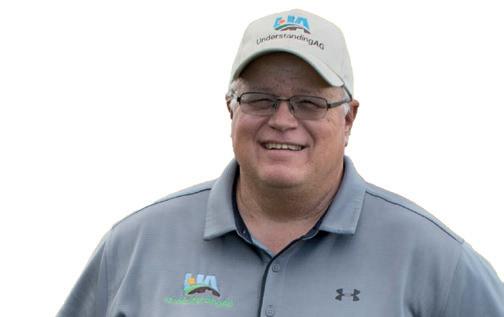


Groundswell also promises a timely appearance for author and founder of The Transition Network Rob Hopkins, How to Fall in Love with is released in the run-up to







Voted a top 100 environmentalist by The Independent, Mr Hopkins said he was thrilled to speak to farmners at the twoday event. Love is the to the festival. day event.




















































Guttridge is dedicated to delivering reliable, cost-effective bulk handling equipment designed for low-maintenance and long operating life.
Over 60 years of experience has equipped us with the knowledge and expertise to be able to offer advice and solutions for any aspect of bulk materials handling.













Now
Alternatively,
a
Beef cattle reared on a grassrich regenerative farming system can store more carbon than they emit – helping to mitigate climate change, suggests a study.
Results from the McDonald’s-sponsored project at FAI Farms could see farmers and food companies to back up their net zero balance with solid scientific findings, says soil carbon specialist Agricarbon.
The four-year trial saw FAI Farms introduce switch its rotationally grazed 486ha organic farm in Oxfordshire to an adaptive multi-paddock grazing system.
Cattle became healthier, soil structure and biodiversity improved – and staff were happier, it said.
The farm’s carbon balance was calculated to be beyond net zero (-49.7t of CO2e), thanks to a combination of relatively low emissions and carbon sequestration on permanent pasture.
“We’ve known for some time that healthy soil can sequester high amounts of carbon, and it’s fantastic that these figures can form part of the growing global evidence to back this up,” said Harry Kamilaris at Agricarbon.
“Our data supports companies like McDonald’s with their commit ments for sustainable sourcing from carbon-rich and healthy soils. It allows them to reduce emissions in their sup ply chain by supporting farmers to in troduce advanced grazing practices.”
Agricarbon undertook the sampling for the soil carbon baseline in May 2022 across three key fields, with re sults indicating a total carbon stock of 3,977t - an average of 107t/ha.
“When taken alongside our gross emissions, the results suggest that the farm as a whole is beyond net zero, which is in part due to low emissions, alongside carbon sequestration in our permanent pastures,” says Karl Wil liams at FAI Farms.
Adaptive multi-paddock grazing system sees cattle graze intensively on tall pastures for a short time before moving on. This means a longer recovery period for pasture to regenerate – increasing grass yields and the possibility of winter grazing.
The farm bought in a small amount of feed for its 90 dairy store animals. The 80 suckler cows and followers were sustained purely from grazing and forage produced on the farm, says Mr Williams.
Soil organic matter increased from an average of 7.6% to 9.2% at 0-10cm depth, and from 2.7 to 4.4% at 3050cm depth. Active carbon increased by an average of 5% at 0-10cm depth and 81% at 30-50cm depth across the three key fields.
Laboratory soil analysis over the four-year trial showed highlights the importance of measuring throughout the full soil profile to provide a complete picture of the soil carbon dynamics beyond the topsoil alone.
“As soil organic carbon builds rela

An innovative calf shed is helping to reduce respiratory disease in youngstock.
The shed is being developed by livestock specialists Galebreaker and researchers from Scotland’s Rural College (SRUC). Funded by Digital Dairy Chain, the project promises cost savings and productivity improvements for the sector.
The new calf building is designed with a calf centred approach, meaning ventilation and the optimised environment is at the core of the design. It has been constructed on Ross Vance’s High Skeog Farm in Whithorn, Dumfries and Galloway.
Daily liveweight gain and animal behaviour is being monitored through WellCalf sensor records. Lung scanning and farm treatments are also being monitored, with final results expected this autumn.

Four in five UK dairy herds have experienced cryptosporidiosis – with significant financial and welfare implications, say researchers.
Some 84% of farmers surveyed by Harper Adams University said they had dealt with outbreaks of the disease, which causes severe watery diarrhoea. Nearly 60% rating the severity as 7 or higher, with 10 being the most severe.
The survey of 63 farmers from across the UK in spring 2024 highlighted financial losses ranging from £300 to £30,000, with 68% of respondents citing financial strain due to increased vet bills, extended rearing times, and lower sale values.
Almost three-quarters (70%) of re-












spondents said affected calves were less profitable, with poor growth rates being the most common reason. Additional costs include increased labour for managing sick calves.
Understanding infection
This mirrors other UK studies, which show that calves infected within the first 16 days of life gained significantly less weight over six months, leading to a potential £161 reduction in sale price per calf.

Cryptosporidiosis occurs when calves ingest the parasitic protozoan Cryptosporidium parvum (C. parvum), which produces vast numbers of encysted eggs (oocysts) shed in the faeces of infected animals.







Calves between five days and two weeks of age are most affected, with symptoms including colic (gut pain), reduced feed intake, watery scour and dehydration, according to the study by animal production science graduate Alice Powell.










































After witnessing the devastating effects of C. parvum firsthand, Ms Powell decided to work as a ruminant specialist at Massey Feeds – a company offering specialist feed and milk products to support calf health.
“On one farm I worked at, there were a lot of calf deaths – and the calves were severely dehydrated” she
“You could just smell it in the sheds. After testing, they found they had C. parvum, so they became very strict about cleaning, disinfecting, and colostrum management.”
Ms Powell says the farm even invested in new calf accommodation with non-permeable surfaces that were easier to clean and disinfect. Her study revealed serious gaps in biosecurity and prevention. Some measures ranked as most important also had a high number of farmers stating they were not important, said Ms Powell. Some 28 farmers considered thorough cleaning of feeding
equipment very important, while 18 disagreed. But four in five farmers reported cleaning and disinfecting after an outbreak.
More than half of respondents were using preventive measures, with cleaning equipment, good colostrum management, and correct calving protocols ranked as the most effective.
One issue raised was that many farmers were either using the wrong disinfectant or unaware that only certain disinfectants are effective against cryptosporidiosis.

Having the correct electrolyte protocol is crucial. Some farmers mentioned adding electrolytes to milk, but this can affect the osmolality in the calf’s digestive system, leading to dehydration rather than rehydration, said Ms Powell. “Electrolytes must be provided separately from milk feeds.”
Kat Baxter-Smith from MSD Animal Health highlighted the multifactorial nature of managing infectious calf scour. She added: “No single solution exists, but good biosecurity, vaccination, nutrition, and hygiene help minimise disease problems.”
The research also gauged awareness of Bovilis Cryptium, the first-ever vaccine for cryptosporidiosis. At the time of the survey, it was not yet available in the UK, having only been launched in late 2024.
But 81% of respondents who were aware of the vaccine said they would use it, citing better calf welfare, reduced mortality and improved productivity as key reasons for wanting access to the product.
Administered to pregnant cows in the third trimester, the vaccine requires two doses given 4-5 weeks apart, with the final dose completed at least three weeks before calving. For subsequent pregnancies, a single booster dose is required.
“By vaccinating cows in late pregnancy, antibodies against C. parvum are raised in colostrum, reducing clinical signs of disease in newborn calves,” explained Kat Baxter-Smith.
When used alongside excellent colostrum management and strict hygiene, vaccination can significantly improve calf health and farm efficiency, said Ms Baxter-Smith. “Farmers interested in further information should contact their local vet.”
An innovative project aimed at boosting efficiency and productivity in the livestock industry through enhanced water technology is gaining momentum.
British agri-tech firm Oxcel has reported successful outcomes from Innovate UK-funded trials, confirming that its nano-oxygen-enhanced water technology delivers significant benefits for both farmers and the environment.
The trials were carried out with Scotland’s Rural College (SRUC) and the UK Agri-Tech Centre. Oxcel said its plug-in farm-ready solution yielded promising results for the UK’s the intensive livestock industry.
The system enhances dissolved oxygen levels in drinking water, helping to increase levels of animal welfare, productivity and carbon efficiency –all without requiring changes to farm infrastructure.
Field trials with poultry producers reported reduced mortality, fewer abattoir rejections and increased carcass weights. Pig trials resulted in faster growth rates, improved feed efficiency, reduced feed intake and slaughter weights five days earlier.
SRUC’s research showed oxygenenriched drinking water significantly improved broiler welfare indicators, including reducing hock burns and white striping, better feather condition and improved gut health.
SRUC professor of poultry nutri-

tion Farina Khattak suggested the system could offer a farmers a prac tical and scalable water supply. “Wa ter quality is vital for animal health, yet it is often overlooked,” she said.
“Our research demonstrated that oxygen-enriched water can signifi cantly enhance both welfare and meat quality, offering farmers a practical, non-pharmaceutical solution to im prove production standards.”
At the core of the system is a simple, nanobubble delivery system that quad ruples the amount of dissolved oxy gen in drinking water. Commercial trials have shown that welfare im provements and profit increases can go hand in hand.

By enhancing gut health and resilience, this technology enables farmers to achieve higher animal welfare standards, greater liveweight gains and better farm economics without disrupting existing infrastructure.
Oxcel said founder and chief executive Alex Leigh said the company engaging with investors to scale up the technology – delivering better profits for farmers while reducing the environmental impact of meat production.
Fiona Short, livestock innovation lead at the UK Agri-Tech Centre, said the project was an excellent example of how Innovate UK funding could successfully bring industry and academia together to enhance livestock production.

Poultry handling specialist Jonah’s Handling has been acquired by livestock biosecurity and protection experts Livetec Systems.
Jonah’s Handling has more than 18 years of experience across Norfolk and Lincolnshire, particularly in the turkey sector. The acquisition strengthens Livetec’s position with an expanded portfolio, says Livetect managing director Gordon Samet.
“Welcoming Jonah’s Handling into the Livetec portfolio is a major step in expanding our offering to deliver an even broader range of services to meet the poultry industry’s increasing needs,” he explains.
“This acquisition enables us to offer fully integrated, end-to-end depopulation and handling services, positioning us to better support our clients in overcoming operational challenges, enhancing efficiency, and improving overall resilience.”














To maximise milk yields from forage remember to add Molasses!
For more information about our extensive range of liquids and to find your local merchant please call us on 0151 955 4850 or visit www.unitedmolasses.com




WE PROVIDE MOBILE FEED MILLING AND MIXING SERVICES FOR ALL BREEDS OF ANIMALS AND POULTRY, FROM STRAIGHT ROLLED CEREALS OR HAMMERMILLED PULSES TO COMPLETE MIXED RATIONS AND FEED BIN TRANSFERS. MOBILE FEED MILLING AND MIXING SERVICES FOR ALL BREEDS OF ANIMALS AND POULTRY



With numerous suction and discharge options including directly into feed bins or separate bunkers, we are able to provide an efficient, traceable and consistently high standard of service for our customers.
Based in the West Midlands we run a fleet of modern ‘Tropper’ machines specifically built for precise mixing and accurate weighing operated by our experienced, friendly drivers.


To discuss your farm’s requirements please give us a call on: James - 07584 582 598 Glyn on 07976 548766 / 01568 750 183
E: info@glynhamermillmix.co.uk
W: www.glynhamermillmix.co.uk



















Sheep farmers are being advised to apply insect growth regulator to flocks amid an increased risk of blowfly strike.
The free Blowfly Watch service, run in partnership with NADIS, uses a combination of factors – including soil temperature and humidity – raised its blowfly strike risk warning last month.
Matt Colston, ruminant technical consultant at Elanco, says producers should consider early preventative action when the service issues risk alerts in your area. Farmers can protect flocks by applying an insect growth regulator, he adds
“Damage happens fast – it can take as little as 36 hours from an egg being laid on a sheep to maggots eating its flesh – so prevention is better than waiting to see a struck lamb before treating the whole flock.”
Mr Colston says the CLiK range of growth protectors provides options for all types of sheep, whatever the management system –with protection ranging from eight to 19 weeks, and meat withdrawal periods ranging from seven to 40 days.
Mr Colston’s top tips for applying a preventative treatment include using an appropriate applicator gun with a fan spray nozzle. This should be carefully calibrate it before
use, he says.
The correct dose should be applied to a clean fleece, with any dirty animals clipped or dagged before application. The product should be applied in a band about 10cm wide, holding the gun about 45cm from the sheep.
Mr Colston says the efficacy of preventative treatment relies on the product being applied to clean sheep – aided by effective worm control, as well as actions such as dagging and timely shearing.
“Worm management plays a valuable role in preventing strike, because scouring, due to worms, can cause dirty backends and encourage flies. Regular faecal egg counting will help identify worm burdens early and prompt treatment before lambs scour.”
Preventative treatments should always be properly and carefully applied








Like it or loathe it, electronic identification in the sheep sector has made monitoring lamb growth rates easier than ever, writes Nerys Wright. Although official aggregated data is unavailable – and much of the research is diet-specific – knowing the daily liveweight gain (DLWG) of your lambs is invaluable when it comes to improving crop performance.
Lamb weight gain can vary significantly based on factors such as age (as feed conversion ratio declines with age), grazing quality, feed availability, parasite burden, and overall flock health.
Additionally, ewe condition and milk production play crucial roles.
If ewes maintain condition from tup-
ping, mobilising body fat during lactation helps with milk production. However, ewes under condition at lambing will struggle to achieve optimum milk yield and may end up thinner by weaning.
Natural peak milk yield occurs 3-4 weeks post-lambing, after which milk production decreases, encouraging lambs to forage and develop their rumen. Keeping ewes well-fed during lactation maximises peak milk yield and benefits lamb performance.


It's easy to suggest a target, but it's not one-size-fits-all. Growth rates vary by management group, lamb age, weather, and diseases such as lameness, parasites, and trace element deficiencies.
Generally, we aim for lambs to reach 20 kg at 8 weeks and 30 kg at weaning (12 weeks). This can be adjusted according to past flock performance and individual farm conditions. Monitoring worms based on daily live-weight gain al-
No one-size-fits-all for maximum growth rates
lows us to treat underperforming lambs. But you need to know how well wormers work on your farm throughout the year. If worming a proportion of the flock, use an effective product.
Nerys Wright is an independent sheep consultant. For more details, call 07891 187643 or visit sheepconsultancy.co.uk.











See us at Agri










































OR EXTERNAL
•STEEL FIXING


RUSH, TAMP OR POWER
FLOATFINISHES
•FOUNDATIONS

• AND RDS




MATERIAL ADVICE AND COSTING
•SILO BASES
Wisbech, Cambs
PRONS &SHED FLOORS
&SHED FLOORS
•ANAEROBIC DIGESTION TANK BASES
•GRAIN, POTATO& MACHINERYSTORES
•PATHS, PATIOS AND DRIVEWAYS •GROUNDWORKS & PREPARATION












Equipment - Livestock - Feed - Fertiliser - Seed - Cash Flow
Equipment - Livestock - Feed - Fertiliser - Seed - Cash Flow
Diversification Projects - Building - Debt Consolidation
Diversification Projects - Building - Debt Consolidation




• Finance from £10k to £5m
• Excellent rates
• 6-month to 20-year terms
• Tax efficient
• Simple, quick phone application

Equipment - Livestock - Feed - Fertiliser - Seed - Cash Flow Diversification Projects - Building - Debt Consolidation


• Decision within 24-hours
• Bad credit history, large debts... No problem!
• High street banks unsupportive
• Tenant farmers welcome
We bring the personal touch back into farm finance. For the personal touch, ring George Bridgman on 07522 731193 george.bridgman@abfltd.co.uk










• Latest launch of FETF grants
• Six-week application window
• Goal to boost farming profits
Amulti-million-pound fund opens for applications this month to boost farm profitability, productivity and food security.
The £46.7 million Farming Equipment and Technology Fund (FETF) offers three types of grant – each worth up to £25,000. It can be used to purchase machinery and equipment, manage slurry or improve animal health and welfare.
The aim is to help reduce farm costs while increasing efficiency and sustainability. Examples include seeddrilling systems which cut costs, arable yield monitors, or slurry separator systems to reduce reliance on fertiliser.
A £5 million Investor Partnerships programme will blend government grant money with private investment to bring cutting edge technology to market, giving farmers faster and more widespread access to state-ofthe-art innovations.
Defra farm minister Daniel Zeich-

ner said: “Equipment and technology help drive farming forward and we will work with investors to fund more resilient, sustainable farms boosting profitability, productivity and food security."
Mr Zeichner added: “This is the Plan for Change in action and these grants will help provide our farmers with the equipment necessary to adapt, compete, and grow no matter what challenges lie ahead.”
A successful pilot has already reduced reliance on seasonal labour through bringing high-yield broccoli harvesters to market and helped crops grow healthier and faster without chemicals by using new seed cleaning technologies.
The government has repeatedly said it wants to increase the profitability of the farming industry. Defra says the new grant will help to protect food supply chains – and also create a
Funding includes grants to help purchase arable machinery
“Technology helps driving farming forward
Alice Mead has been appointed head of the GWCT Allerton Project, which researches the benefits of different farming methods on wildlife and the environment.
With a background in sustainable agriculture and regenerative practices, Ms Mead brings over a decade of hands-on experience helping farmers adapt to environmental change and adopt more collaborative approaches.
Alastair Leake, who over 25 years has been instrumental to the Allerton Project’s success, will continue as project director while extending his broader role as policy director for the Game and Wildlife Conservation Trust.
Dr Leake said: “I am delighted to hand over the reins of management to Alice to take the project forward to the next stage at a both exciting yet challenging time for farming and the environment. There is no better person to take up this challenge.”
Before joining Allerton almost three years ago, Ms Mead spent seven years with the Linking Environment and Farming charity (LEAF).
She said: “I look forward to driving forward our work—developing new initiatives, filling knowledge gaps, and enhancing communication so that our research leads to tangible improvements on farms and in the broader countryside.”
more sustainable agricultural sector.
The announcement follows £45.6m in funding to help drive the development of new inventions and technologies, helping farmers increase their profits, boost food production and help nature.
Defra has published a list of eligible items which can be funded using a FETF grant. Some items, scores and specifications in this list have changed from those available until the FETF last year. Some equipment may no longer be eligible.
The grant is competitive, which means applicants may not receive all the funding they apply for. Farmers are expected to part-fund the purchase of new equipment rather than receiving the total cost of a new machine.
The only application window for all FETF 2025 grants will open on Thursday 29 May and will close at midday on 10 July 2025. Applications submitted after this time will not be accepted, says Defra.
For full details, bit.ly/FETF2025

challenging
for UK agriculture
Soil health and economic pressures will be discussed at a dedicated Regenerative Agriculture conference at this month’s Cereals event.
Hosted by BASE UK and sponsored by sponsored by Tees Law, the conference will run across both days of the event – held on 11-12 June at Heath Farm, near Leadenham, Lincolnshire.
Speakers and farmers will discuss practical, resilient solutions to the challenges faced by arable growers –with an increasing number of producers rethinking their rotations and management systems.
“It is especially exciting as knowledge exchange is the foundation of our organisation, and the majority of our speakers are members,” explained BASE UK administrator Rebecca Goodwin.
“This highlights the wealth of knowledge, expertise and innovation that exists within our network. Our members work with the system day after day and can provide practical insights and expertise to the industry discussions.”
BASE UK chairman Edwin Taylor believes the push towards regenerative methods is being fuelled by necessity, rather than ideology – although there is some of that too among regenerative farmers.
Mr Taylor said: “As a result of seeing a significant decline in the resilience and workability of their soils, many farmers are exploring changes
to their farming practices to rebuild soil health.
Some may have investigated this op tion when the sustainable farming in centive (SFI) offered support for this transition, but even without such schemes there are still many compel ling benefits and reasons to adopt re generative practices.”
In a session called ‘Enterprise stack ing – the regen way’, BASE UK mem ber Seb Richardson will discuss how he uses different enterprises on his fam ily farm to achieve multiple benefits.
A fifth-generation farmer, Mr Rich ardson farms beef and arable in partnership with his parents across 700ha of Northamptonshire. The farm has been regenerative since 2019, when the family turned to a non-plough based system.

Cereals offers a range of attraction for arable growers
ton Estate in north Yorkshire, will also be sharing his journey at the conference, drawing on more than a decade of experience in conservation agriculture.
Regenerative farming offers an opportunity to stack enterprises in the same field, says Mr Richardson, who has introduced Sustainable Farming Incentive options, carbon credits, livestock integration and bi-cropping.
“We still focus on food production, but enterprise stacking allows us to do this while diversifying the farm. We were able to join the SFI before it closed. Hopefully by the time Cereals comes around we will know more about the next SFI.”
Farm manager John Aynsley, who farms just under 1,600ha on the Skel-
Recently, Mr Aynsley has explored enterprise stacking as a way to plan for the future. “If you don’t prepare to work with no subsidy, then you may be on the back foot in a few years’ time,” he says.
“Food production is not at the top of this government’s priorities, so events like Cereals are important; as no matter how old you are there’s always something new that can be learnt.”
Stacking enterprises, like integrating livestock with arable rotations, is important for a farm’s profitability, says Mr Aynsley. It provides a more resilient income stream, which helps cashflow.
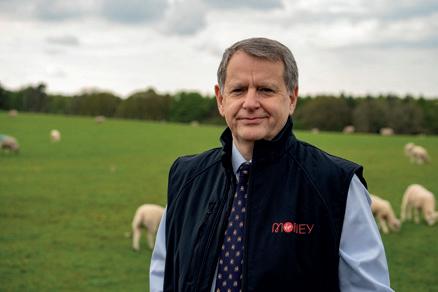
arming has faced more than its fair share of challenges in recent times. Changes to inheritance tax and to support arrangements are just two major issues to mention but individual farms will have seen many others as they look to futureproof their businesses.
Given the challenges and the increasing complexity around how farming businesses
plan effectively for the future, it is essential farmers plug into their professional support to help them understand their options.
Time spent with trusted land agents, accountants, solicitors and bank managers is a good investment as it helps farmers better understand the challenges and the best solutions.
Recent inheritance tax changes will affect a significant number of farm businesses, with precious little time to plan for those changes.
In many cases, I have seen farmers use their professional advisors to seek the views of the wider family and then use this feedback to refine plans, based on a clearer understanding and consideration of the family members’ ambitions going forward.
The quality of professional support in the agricultural sector and the close, long stand-
ing relationships advisors have with their farming clients is well known.
With all the changes happening in the sector, farmers need to make time to plan for the future and involve professionals and advisors at an early stage to help with the process.
Sometimes to generate new ideas and inspiration, it also helps invite a new face such as a specialist consultant to the table, to have a fresh look at what’s happening.
We often find ourselves working together with other professionals to make sure the best outcome is achieved for the client.
This sharing of knowledge is important, as is the continuity it can bring, given the long term nature of the industry. Teamwork ensures the business’s strategy is undertaken efficiently and cost-effectively
Brian Richardson, is UK head of agriculture at Virgin Money.

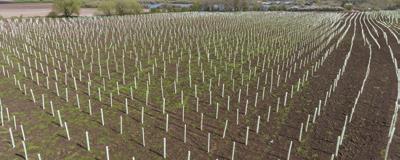
















Like it or not, Donald Trump’s tariffs and trade agreements are bad news for British farmers, says Clodhopper
What is it about us older farmers? Do we just not understand stuff? Has our thought process slowed down so much we are losing touch with reality?
Having briefly read the statement by Keir Starmer, I cannot for the life of me see how the UK-US trade deal announced by London and Washington will benefit British industry or farming – let alone consumers.
So far, details are lacking. Neither the Americans nor the British governments have published any worthwhile information about the agreement – or tariffs. At least not enough for us to make an informed decision on its implications.

The finer details are expected to be settled in the coming weeks, as politicians like to say. But it is already clear that anyone hoping
It is clear tariffs will remain “

Donald Trump will scale down his demands for more market access to the UK is likely to be disappointed.
The flat-rate across-the-board 10% tariff announced by Trump on UK goods imported into the USA remains. This is being lauded as a good thing – presumably because it is lower than the feared 25% tariff everyone else seems to be paying.
Rather than nothing, which would be sensible, the White House has – so it seems –merely agreed to scale down the levies it wanted to impose while claiming it has secured positive changes for sales of American beef into British markets.
And even though steelmakers and car manufacturers seemed to breathe a sigh of relief at the reduced tariff rate, it is still clear that tariffs will remain for some time to come. So everyone will pay the price for Trump’s political posturing.

The American Beef Association said it welcomed the new beef deal for America. But more work is needed. British beef farmers have not been so positive with many expressing concerns about the impact on our domestic beef industry.
Concerns voiced by farmers and consumers for a number of years centre on the food production methods used in the USA.

This includes hormone treated beef and chlorine washed chicken. Many agree that British farmers simply cannot compete with cheaper imports produced using methods that would be illegal here: hormone beef because of safety fears and chlorine chicken because it masks dirty farming practices.
True, the British public might want cheaper food. But sometimes people also lack the understanding of where it comes from. Yes, the price of beef from my local butcher is considerably more than the supermarkets but it is also far superior in quality.
It’s not just about meat either. The removal of UK tariffs on American ethanol could be the final nail in the coffin for many bioethanol plants here in the UK. And that has implications for UK growers who keep them fed with wheat.
A recent statement from AB Foods chief executive George Weston said the company’s bioethanol plant in Hull has already faced significant problems due to subsidised ethanol imports.

Now we face a flood of tariff-free ethanol imports that will only make the situation worse. It seems the British government’s concessions on beef and ethanol were in return for favourable terms for steel and the car industry.
Once again, this government’s attitude and lack of understanding towards British farming rears its ugly head. No wonder a significant number of growers are warning that this harvest may be the final straw for many farms.







